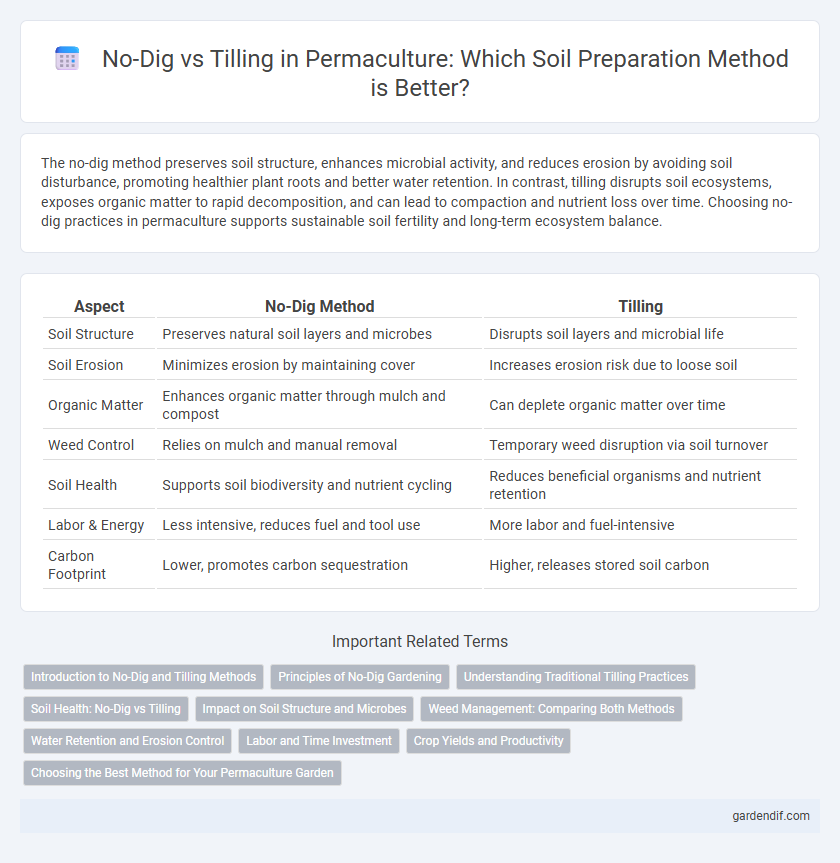
No-dig method vs Tilling Illustration
The no-dig method preserves soil structure, enhances microbial activity, and reduces erosion by avoiding soil disturbance, promoting healthier plant roots and better water retention. In contrast, tilling disrupts soil ecosystems, exposes organic matter to rapid decomposition, and can lead to compaction and nutrient loss over time. Choosing no-dig practices in permaculture supports sustainable soil fertility and long-term ecosystem balance.
Table of Comparison
| Aspect | No-Dig Method | Tilling |
|---|---|---|
| Soil Structure | Preserves natural soil layers and microbes | Disrupts soil layers and microbial life |
| Soil Erosion | Minimizes erosion by maintaining cover | Increases erosion risk due to loose soil |
| Organic Matter | Enhances organic matter through mulch and compost | Can deplete organic matter over time |
| Weed Control | Relies on mulch and manual removal | Temporary weed disruption via soil turnover |
| Soil Health | Supports soil biodiversity and nutrient cycling | Reduces beneficial organisms and nutrient retention |
| Labor & Energy | Less intensive, reduces fuel and tool use | More labor and fuel-intensive |
| Carbon Footprint | Lower, promotes carbon sequestration | Higher, releases stored soil carbon |
Introduction to No-Dig and Tilling Methods
The no-dig method in permaculture emphasizes minimal soil disturbance by layering organic matter on top, promoting microbial health and natural soil structure. Tilling, conversely, involves mechanically turning the soil to prepare beds but can disrupt soil ecosystems and increase erosion. No-dig gardening improves soil fertility and water retention through natural decomposition, while tilling temporarily aerates soil but may degrade long-term soil quality.
Principles of No-Dig Gardening
The no-dig method emphasizes preserving soil structure and microbial life by avoiding disturbance, maintaining organic layers that promote biodiversity and nutrient cycling. This approach conserves moisture, reduces erosion, and enhances soil fertility through natural decomposition rather than mechanical tilling. By fostering a healthy soil ecosystem, no-dig gardening supports sustainable plant growth and long-term soil health.
Understanding Traditional Tilling Practices
Traditional tilling practices involve turning the soil to aerate and prepare seedbeds, which can disrupt soil structure and microbial communities. In contrast, the no-dig method preserves soil integrity by minimizing disturbance, promoting beneficial organisms, and maintaining organic matter on the surface. Understanding the impact of tilling on soil health is crucial for adopting sustainable permaculture techniques that enhance long-term fertility and ecosystem resilience.
Soil Health: No-Dig vs Tilling
No-dig methods preserve soil structure and microbial life by minimizing disturbance, leading to improved water retention and nutrient cycling in permaculture systems. In contrast, tilling disrupts soil aggregates, reduces organic matter, and increases erosion risk, compromising long-term soil fertility and health. Maintaining intact soil ecosystems through no-dig practices supports robust plant growth and sustainable land management.
Impact on Soil Structure and Microbes
The no-dig method preserves soil structure by minimizing disturbance, which maintains beneficial microbial communities and promotes natural aeration and water retention. In contrast, tilling disrupts soil aggregation and microbial habitats, leading to accelerated organic matter decomposition and potential erosion. Studies show no-dig systems increase microbial biomass and diversity, fostering healthier soil ecosystems compared to traditional tilling.
Weed Management: Comparing Both Methods
No-dig permaculture methods naturally suppress weeds by preserving soil structure and encouraging beneficial microbes and earthworms, which outcompete weed seeds for nutrients. In contrast, tilling disrupts soil layers, bringing dormant weed seeds to the surface where they can germinate and increase weed pressure. Employing no-dig techniques reduces labor-intensive weed control while enhancing soil health and long-term garden productivity.
Water Retention and Erosion Control
No-dig permaculture gardens enhance water retention by preserving soil structure and maintaining organic matter on the surface, which acts as a natural mulch, reducing evaporation. Tilling disrupts soil aggregates and exposes nutrients to erosion, leading to increased water runoff and accelerated soil degradation. By avoiding tilling, the no-dig method promotes deeper water infiltration and significantly minimizes erosion, supporting healthier plant growth and sustainable land management.
Labor and Time Investment
The no-dig method significantly reduces labor and time investment compared to traditional tilling by eliminating the need for intensive soil turning and preparation. This approach relies on layering organic matter to enhance soil fertility naturally, saving hours of manual work while promoting soil structure and microbial life. In contrast, tilling demands repeated, time-consuming physical effort to break and loosen soil, increasing both labor costs and potential disruption to beneficial soil organisms.
Crop Yields and Productivity
The no-dig method enhances soil structure and microbial activity, leading to increased crop yields and long-term productivity by preserving soil integrity. Tilling disrupts soil ecosystems and can reduce nutrient availability, often resulting in lower crop resilience and decreased productivity over time. Studies show no-dig systems produce consistently higher yields while maintaining sustainable soil health compared to conventional tilling.
Choosing the Best Method for Your Permaculture Garden
The no-dig method preserves soil structure, promotes beneficial microbial activity, and reduces erosion, making it ideal for sustainable permaculture gardening. Tilling can temporarily aerate the soil but often disrupts soil ecosystems and accelerates nutrient loss, which may hinder long-term soil health. Selecting the best method depends on soil condition, crop type, and environmental goals, with no-dig practices generally favored for maintaining ecological balance.
No-dig method vs Tilling Infographic

 gardendif.com
gardendif.com